“Glorious Urfa” Population: 597,000
Old name: Edessa
Market: Sunday morning (pigeons)
Of all the big cities out east, Şanlıurfa (or just plain Urfa to its friends) has to be the most visually beautiful. This is not immediately obvious as you pull into town since the usual high-rise suburbs completely conceal the pretty centre from view, but as soon as you have struggled past all that urban blight, there it is – a honey-coloured historic town bursting with traditional, if conspicuously conservative, character.
A town with a long and complicated history which culminated in its winning the şanlı (glorious) prefix after it resisted the French occupation of 1918-20, Urfa is the famous City of the Prophets, the place where İbrahim (Abraham) is believed to have been born in a cave and where Job lived for seven years in a second cave while patiently waiting for God to restore his health. It’s still an important place of pilgrimage for Muslims from all over the Middle East who converge, in particular, on the Hazreti İbrahim Dergahı near İbrahim’s birthplace.
Back then King Nimrod was much vexed by a prophecy that a new-born baby would grow up to overthrow him. Like King Herod, he concluded that the best way to rid himself of the threat would be to kill all the babies in the town. To protect him from such a fate, İbrahim’s mother kept him in hiding for the first seven years of his life. Years passed and the Prophet managed to fall foul of Nimrod anyway by refusing to worship the Assyrian idols. As punishment the king had him taken up to the hilltop now crowned with the remains of a castle. Here he tried to have him burned on a pyre, only to find the fire miraculously converted into water and the coal into fish.
Infuriated, Nimrod tried a different tack, tying İbrahim to a makeshift catapult and hurling him from the hill; by another miracule he landed in a bed of roses that saved his life. A not dissimilar story was told about the fate of his disobedient daughter, Zeliha, whose name lingers on in the shape of the pretty Aynzeliha Gölü and its tea garden.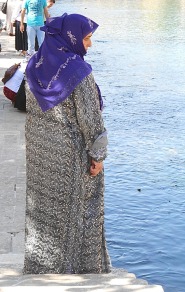
Today these stories are commemorated in the form of a rose garden in front of the cave and a lovely stone-ringed pool full of sacred carp kept comfortably fat by the food fed to them by pilgrims. This is the area known as the Gölbaşı (not to be confused with many other much less significant Gölbaşıs dotting the country).
You should certainly sign up for one of the sıra geceleri hosted by the bigger hotels. Rendering this phrase into meaningful English is virtually impossible but the sıra gecesi was originally a monthly gathering of male friends which took place in each of their homes in turn. These original sıra gecesis were more about conversation than song and dance but the restyled versions offered to tourists differ little from the sort of Turkish nights laid on in other tourist centres. Come with a group of friends and you may be able to recapture at least a taste of the original conviviality.
Don’t leave town without trying:
- çiğ köfte, a form of uncooked meatball served with lettuce
- ciğer (liver) which local men eat at little wooden tables set up along the main drag every evening
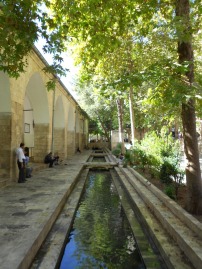 Hasan Paşa Cami
Hasan Paşa Cami
The Gölbaşı area
As a result of the great religious importance of the area, there are many mosques clustered together around the Balıklı Göl (carp pool) and the rose garden. Right beside the cave where İbrahim is believed to have been born stands the enormous Mevlid-i Halil (Dergah) Cami, bustling at all times with the faithful. Although it stands on the site of a synagogue and early Christian church there has been a mosque here since 1523 when it was commissioned by Muhammed Salih Paşa, It was restored in the 1950s and again a few years ago.
In front of the Mevlid-i Halil Cami is the attractive Hasan Paşa Cami, originally built in the 15th century for the Akkoyunlu leader, Uzun Hasan (Tall Hasan). It was rebuilt in 1574 and has been restored many times since. Its single detached minaret stands right beside one of the entrances to the bazaar and a pretty stream runs through the mosque courtyard.
A number of mosques come together around the Baliklı Göl itself. Probably the most interesting is the 13th-century Halilür Rahman (Döşeme) Cami built over the spot where İbrahim was thought to have landed. It stands on the site of a 6th-century church of St Mary which was converted into a mosque during the reign of the Abbasid caliph, Me’mun (813-33). The minaret started life as the belltower of this church. The mosque itself was rebuilt in the mid-16th century. 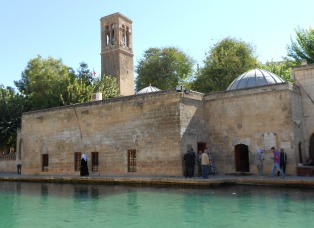 Halilür Rahman Cami
Halilür Rahman Cami
Just past this mosque at the far end of the carp pool is the semi-circular Halilür Rahman Medresesi, built in 1775 and repaired in 1871. More familiar is the 18th-century Rızvaniye Vakfı Camii whose graceful arcaded wall looks so good in photographs. Commissioned in 1736 by Rıdvan Ahmed Paşa, it has two splendid stripy entrances as well as beautifully carved wooden doors. The courtyard still acts as a medrese and, peeping into the hücres (cells), I came as close as I ever have done to imagining what life in a medieval theological school would have been like.
The whole Gölbaşı area has been pleasingly developed with low-rise shops alongside the Hotel Manici. Surrounding the fishpond there’s also a very pleasant park whose tea gardens and small restaurants make great places to rest before embarking on a shopping spree in Urfa’s wonderfully atmospheric bazaar.
Urfa’s state of the art museum (closed Mondays) showcases the mosaics discovered in the Haleplibahçe area of the city, right in the town centre. The mosaics are displayed in a building that resembles a flying saucer; the amazing artefacts from Göbeliktepe and from the main settlements lost to the Atatürk Dam are shown in a glittering building that owes aspects of its design, surely, to Frank Gehry.
The rest of the town
Behind a façade of modernity, the Urfa back streets are full of fine old mansions designed to house the traditionally huge extended families of eastern Turkey. Externally very little tends to be apparent since the strict rules governing female modesty meant that high walls kept the interiors completely concealed. The streets are also so narrow that it’s hard to admire the cumbas (bay windows) cantilevered out over them on sturdy stone corbels.
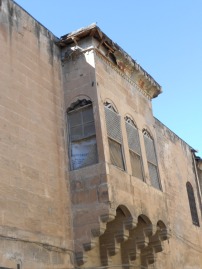 Luckily the erstwhile family home of Hacı Hafızlar, near the post office, is now an art gallery which means that you are free to investigate the huge courtyards and delicate stone verandahs; the local museum also shows off a few fine old doors and windows rescued from some of the derelict houses.
Luckily the erstwhile family home of Hacı Hafızlar, near the post office, is now an art gallery which means that you are free to investigate the huge courtyards and delicate stone verandahs; the local museum also shows off a few fine old doors and windows rescued from some of the derelict houses.
The local authorities are enthusiastically ploughing money into the restoration of the back streets which means that they are becoming ever more interesting to explore.
A particularly interesting area to look out for is around 58 (Hoşgörü) Meydanı where the Nimetullah (Ak) Cami, built originally on the site of an old church, then rebuilt most recently in the late 18th century. Facing it across the road is the elaborately carved facade of the old neighbourhood Karakol (Police Station). In the square itself you can admire the Şeyh Saffet Çeşmesi, a fountain dating back to 1891, as well as a fine late 19th-century building on the site of a lost hamam that now houses a primary school.
Also nearby but not always easy to see behind its high walls and locked gates is the Suryani church of Sts Peter and Paul, known as the Reji Kilisesi from the days after 1924 when it was used as a tobacco factory, then grape store. The current building went up in 1861 although there had been a church on the site since the 6th century. It now serves as the Vali Kemalettin Gazezoğlu Cultural Centre.
It’s also well worth heading uphill along Vali Fuat Bey Caddesi. On the right you will pass the cathedral-sized 19th-century Armenian Apostolic Church of St John the Baptist. Used for a while as a power station, it was restored to serve as the Selahaddin Eyyubi Cami in 1993.
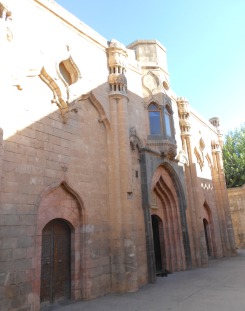 Fırfırlı CamiThat is impressive enough but if you keep walking uphill eventually you will see on the left the newly-built Elçı Konağı. Tucked out of sight behind it is the fabulous Fırfırlı Cami (Frilly Mosque) which started life as the Church of the Twelve Apostles, possibly dating back to 1092 and converted into a mosque in 1956. Its elaborately carved facade with its wonderful ogival arches has no equal in Turkey; it’s as Gothic as it got in these parts of the world. The outside is stunning enough but inside the central dome is exquisite in its simplicity.
Fırfırlı CamiThat is impressive enough but if you keep walking uphill eventually you will see on the left the newly-built Elçı Konağı. Tucked out of sight behind it is the fabulous Fırfırlı Cami (Frilly Mosque) which started life as the Church of the Twelve Apostles, possibly dating back to 1092 and converted into a mosque in 1956. Its elaborately carved facade with its wonderful ogival arches has no equal in Turkey; it’s as Gothic as it got in these parts of the world. The outside is stunning enough but inside the central dome is exquisite in its simplicity.
The strung-out and somewhat austere Ulu Cami (Great Mosque) stands in rather surprising isolation from most of these other monuments, buried down narrow alleys. I found it a wonderfully peaceful oasis from the busy streets perhaps because its courtyard garden and walled graveyard are always full of cats. The minaret started life as the belltower of a church that once stood on the site – presumably the enormous capitals and few columns dotted about the courtyard came from this building or the synagogue that preceded it.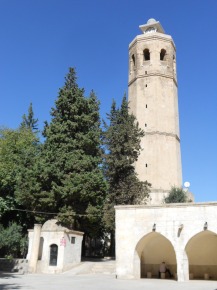 Belltower/minaret of Ulu Cami If you look closely at the walls framing the graveyard you will see arches that must also have been part of one of these older structures.
Belltower/minaret of Ulu Cami If you look closely at the walls framing the graveyard you will see arches that must also have been part of one of these older structures.
Attached to the Ulu Cami is the graceful Nakibzade Medresesi dating back to 1781 and restored in 1876. For some years it served as a primary school.
In an alley near the Ulu Cami Urfa’s Mutfak Muzesi (Culinary Museum) is housed in a stunning stone mansion, one of the finest in town and well worth a quick look even if you’re not much interested in reading about local food.
Looming over everything is Urfa Kalesi, a great vantage point from which to get your bearings. The two columns topped with Corinthian capitals are often linked to the story of King Nimrod. A stepped path up to the castle starts behind the Gölbaşı cafes.
Far less obvious until recently were the old city walls which are now being restored/rebuilt. At one time they were pierced by eight great gates and several soaring towers. The most apparent of these is the restored Mahmudoğlu Kulesi that you will probably come across while hunting out the Harran dolmuşes. Walk round the back to find the impressive Urfa Kent Müzesi (City Museum), sadly labelled only in Turkish.
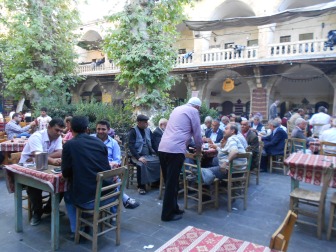 The bazaar area
The bazaar area
The bazaar dates back to the 16th century and the reign of Sultan Süleyman the Magnificent. These days you can come here to shop for mundane household goods and clothes but it’s still a great place to seek out exotic souvenirs too. Some of the nicest are the wispy black and red scarves that local women knot around their heads – although the real fashion item of choice seems to be a lilac-coloured headscarf favoured by both men and women.
The heart of the bazaar is the glorious Gümrük (Yetmiş) Hanı (Customs Inn) which wraps itself around a courtyard shaded by plane trees (I;ve heard rumours that they have been cut down…?) where hundreds of men gather every day to sip çay, chat and play backgammon. Commissioned in 1566 by the governor Beyram Paşa, this is the place to come if you want to hook up with an official or unofficial guide.
Urfa is well-known as a town of pigeon-fanciers and not far from the Gümrük Hanı there’s a street full of small shops where men drop in to size up prize birds. The owners will show you jewellery designed specifically to beautify them: little anklets of coloured beads and dangly ear-rings that wouldn’t look amiss on a woman. If you want to learn more about the birds look for the Çardaklı Kahvehane near the Dabakhane Cami or come here on a Sunday morning when the pigeon market is in full swing.
Eating & drinking
Çay drinkers are spoilt for choice in Urfa. Sitting around the pools in the rose garden is probably the best choice in the heat of high summer but for tea with a view it’s well worth walking up to the Çift Mağara (Twin Caves) cafe beside the castle. A fantastic panorama awaits you.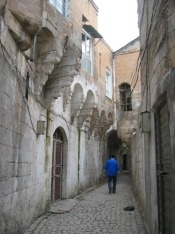
Sleeping
Arte Hotel. Tel: 0414-314 7060
Hilton Garden Inn. Tel: 0414-318 5000
Hotel El-Ruha. Tel: 0414-215 4411
Yıldız Sarayı Konukevi. Tel: 0414-216 6060
The County of Edessa From 1098 to 1150 Edessa was the capital of a small Crusader state whose first count, Baldwin of Boulogne, went on to become the King of Jerusalem. In 1144 the Selçuk ruler of Mosul, Zengi, besieged the city under its then leader, Joscelin II. Despite brief attempts to recover it, that was the beginning of the end for what had been the first Crusader state.
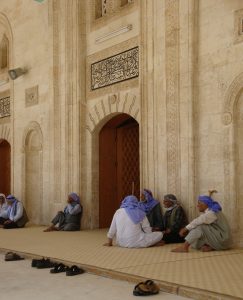
Transport info
The quickest way to get to Urfa is to fly from İstanbul or Ankara. There are also regular buses from Gaziantep, Nizip, Birecik and Mardin.
Urfa’s posh new bus station is in the outskirts of town. Intercity buses leave from the top floor, local buses from the lower floor.
Unfortunately it’s not especially easy to get to the otogar – there is no direct bus, for example, between the otogar and the best hotels around Balıklıgöl and no handy little dolmuşes. Instead you have to take bus No 72 to the local bus interchange and then No 63 to Baliklıgöl. The local bus interchange is within walking distance of Hotel Güven and Beyzade Konağı.
A taxi to town from the otogar will probably cost more than the bus fare that delivered you to Urfa.
Minibuses link Urfa with Diyarbakır via Siverek. They also run to Gaziantep but have a tendency to leave you stranded in the middle of nowhere rather than at Antep otogar.
Day trip destinations
Deyr Yakub Manastırı
Old news but…: https://www.independent.co.uk/news/education/education-news/from-the-sublime-to-the-bazaar-1155576.html
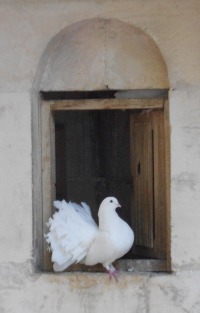 Fantail dove (Kirktelli) in Beyzade Konukevi
Fantail dove (Kirktelli) in Beyzade Konukevi

